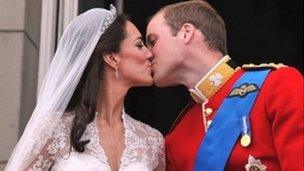Overturning centuries of royal rules
- Published

Any daughters of Prince William and Kate will be the first to benefit from the historic changes
More than a thousand years of royal history will have to change to give daughters and sons equal rights to become Britain's monarch.
What's more, all 16 countries which have the Queen as head of state must change their legislation too.
Government experts admit they are still examining just which laws need to alter.
They have drawn up a list of nine dating back 1689 - but they admit it may not be exhaustive.
One problem is that male primogeniture - which gives younger brothers the right to become monarchs ahead of their elder sisters - is based on many centuries of common law rules of property, not any one piece of legislation.
Legislation being looked at includes: the Bill of Rights 1689, the Act of Settlement 1701, the Coronation Oath Act 1689, the Act of Union with Scotland 1706, Princess Sophia's Precedence Act 1711, the Royal Marriages Act 1772, the Union with Ireland Act 1800, the Accession Declaration Act 1910 and the Regency Act 1937.
No Henry VIII
But what if equal rights to the throne had existed in the past? History might have been very different.
There would have been no Henry VIII nor Charles I. Both had older sisters. Instead of Henry VIII - whose reign saw the setting up of the Church of England - his elder sister Margaret would have been queen if the change had been in force then their father Henry VII was king.
Charles I's reign in the 17th century led to a bloody civil war. But he too had an elder sister, Elizabeth - known as the "Winter Queen" for her brief reign at her husband's side in Bohemia.
In modern times, Queen Victoria's first-born child was a girl - Princess Victoria - in 1840. She married the German Emperor Friedrich III.
Had she become Queen, the crown would have passed to her son - the then German Kaiser Wilhelm II.
With Germany and Britain ruled by the same man, World Wars I and II might never have happened.
If it had been implemented for today's royals, equality would have meant big changes for the current line of succession.
The Duke of York - currently fourth in line - slips back to eighth, behind the Princess Royal (his elder sister), her son Peter Phillips, Peter's daughter Savannah, and Zara Phillips, daughter of the Princess Royal.
Marrying a Catholic
The Earl of Wessex falls from seventh position to tenth after the Duke of York and his two children, Princess Beatrice and Princess Eugenie.
Sweden became the first European monarchy to declare equal rights for male and female children in the line of succession in 1980.
Since then it's been followed by Norway, Netherlands, Belgium, Denmark and Luxembourg.
Tackling the ban on those marrying a Catholic becoming a monarch means changing the Act of Settlement. It was originally drawn up in the reign of William III.
Ill and childless at the time, his sister-in-law Anne had just lost her only child. With no heir it was feared that the succession would fall to the deposed Roman Catholic James II or his offspring.
In the UK the legal changes are not expected to come in for at least another four years - and by then we may well know if, for the Duke and Duchess of Cambridge, they have made any difference at all.
- Published20 April 2011
- Published20 April 2011